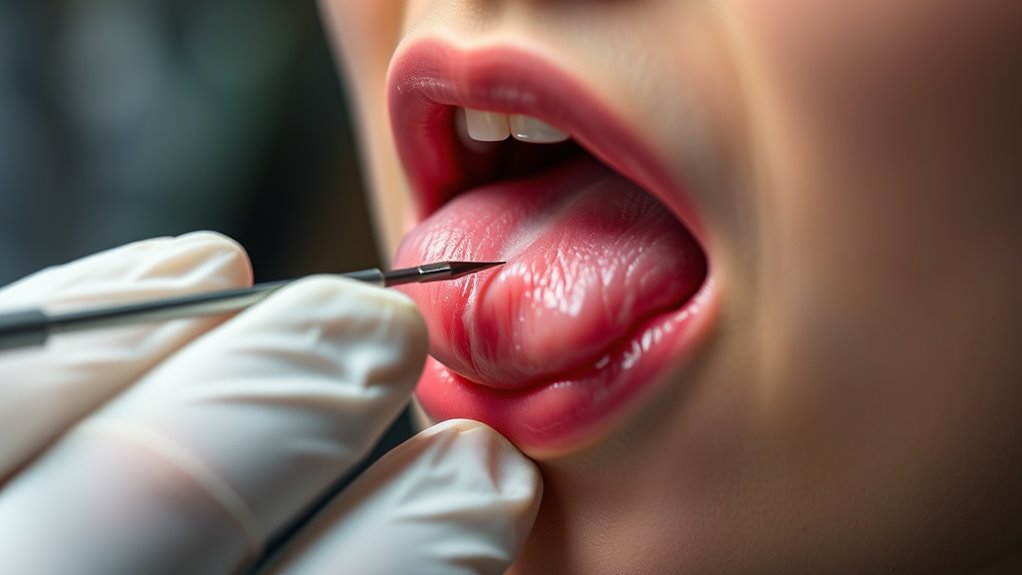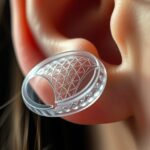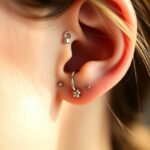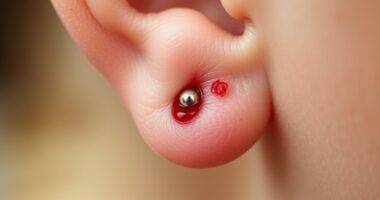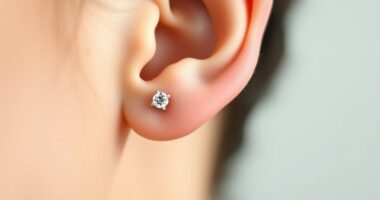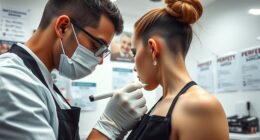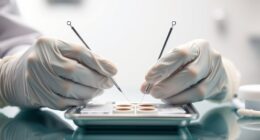To guarantee precision in oral piercings, carefully evaluate your oral anatomy, including tooth position, gum line, and lip movement, before marking the placement. Use sterile tools and proper lighting to minimize errors. Consult with a skilled piercer who uses accurate techniques like visual assessment combined with high-quality imaging if needed. Proper jewelry selection and cautious insertion are key. Continuing with this guide will reveal expert tips to perfect your placement and promote ideal healing.
Key Takeaways
- Conduct detailed oral anatomy assessment, including tooth positioning, gum line, and lip movement, for accurate piercing site determination.
- Utilize precise measurement tools and marking techniques to identify optimal placement, avoiding shallow or overly deep sites.
- Consider aesthetic and functional factors to align piercing placement with natural oral structures and desired appearance.
- Select biocompatible, appropriately sized jewelry to minimize trauma during and after placement.
- Follow professional protocols and use specialized instruments to ensure consistent, accurate, and safe piercing positioning.

Oral piercings require precise placement techniques to guarantee safety, comfort, and aesthetic appeal. When you decide to get an oral piercing, understanding the importance of accurate placement is crucial. Skilled piercers pay close attention to anatomy, ensuring the piercing sits in a position that minimizes discomfort and reduces the risk of complications. Proper placement not only enhances the piercing’s appearance but also influences the healing process. If a piercing is placed too shallow or too deep, it can lead to prolonged healing, irritation, or even migration. That’s why experienced piercers carefully evaluate your oral anatomy, considering factors such as tooth positioning, gum line, and lip movement, to determine the optimal spot for your piercing.
Once the placement is finalized, jewelry selection becomes a key factor in ensuring a smooth healing process. The right jewelry should be made of biocompatible materials like surgical steel, titanium, or niobium, which are less likely to cause allergic reactions or irritation. During the initial healing phase, smaller or appropriately flexible jewelry helps reduce trauma to the piercing site, allowing it to heal without unnecessary stress. As healing progresses, you may opt for different styles or sizes, but it’s vital to follow your piercer’s advice on when and how to change jewelry to avoid disrupting the healing tissue. The choice of jewelry also impacts comfort—smooth, well-polished pieces with secure but not overly tight fittings help prevent irritation and accidental biting, which can delay healing or cause swelling.
Your piercer will provide guidance on how to care for your oral piercing during the healing process. This includes avoiding certain foods, beverages, and oral habits that could irritate the piercing or introduce bacteria. Proper aftercare combined with suitable jewelry selection reduces the risk of infection and ensures your piercing heals efficiently. Additionally, understanding the importance of placement helps you set realistic expectations about healing times and potential complications. If the piercing isn’t placed correctly, it might cause persistent swelling, pain, or even tissue damage, which could extend the healing process or require additional intervention.
Frequently Asked Questions
How Do I Care for My New Oral Piercing?
To care for your new oral piercing, prioritize dental hygiene and follow proper piercing aftercare. Gently rinse your mouth with a saline solution after meals and avoid touching the jewelry with unwashed hands. Steer clear of spicy, hot, or acidic foods that can irritate your piercing. Regularly clean the area, and avoid playing with the jewelry to prevent infection. Consistent care helps your piercing heal quickly and stays healthy.
What Are Common Complications After Placement?
You might think your new oral piercing is invincible, but beware! You’re at risk of infection that could turn your mouth into a battlefield, and nerve damage that might make your tongue or lips feel numb forever. Swelling, bleeding, or persistent pain aren’t just minor annoyances—they could be signs of serious complications. Protect yourself by following proper care and visiting your piercer if anything feels off.
How Long Does Healing Typically Take?
You can expect the healing timeline for oral piercings to vary from a few weeks to several months, depending on factors influencing healing like piercing location, your oral hygiene, and overall health. Typically, initial healing takes 2-4 weeks, but full recovery may take 3-6 months. To promote proper healing, follow your piercer’s aftercare instructions, maintain good oral hygiene, and avoid irritants like smoking or alcohol during recovery.
Are There Age Restrictions for Oral Piercings?
Did you know that over 50% of teens consider oral piercings? Age restrictions for oral piercings vary, but most places require you to be at least 16 or 18. Legal considerations are important, and it’s best to verify local laws before getting pierced. If you’re underage, parental consent is often necessary. Always choose a professional piercer to ensure safety and compliance with age restrictions.
Can I Switch Jewelry Types Easily?
Yes, you can switch jewelry types easily, but you should consider jewelry materials and placement adjustments. Using hypoallergenic materials like surgical steel or titanium minimizes irritation. When changing jewelry, make sure your piercing is fully healed to avoid complications. Consult your piercer for proper placement adjustments, especially if you’re switching to different styles or sizes. Proper care and professional advice help ensure a smooth transition and maintain your piercing’s health.
Conclusion
Mastering precise placement techniques guarantees your oral piercing heals beautifully and comfortably. Did you know that over 70% of oral piercing complications stem from improper placement? By following expert methods, you reduce risks and enjoy your new piercing confidently. Remember, careful planning and accurate technique make all the difference. Trust in the process, and you’ll achieve stunning results that last. Your perfect piercing is just a precise placement away—so take your time and get it right!
Piecing together a life one day at a time, that’s me. I’m Rusty, and I love being editor-in-chief of creative piercing. It’s my passion to help others see their vision and bring it to life. When I’m not working or taking care of my family, you can find me reading a good book or eating pie (of course!).

